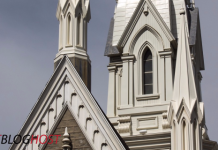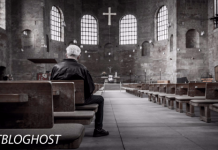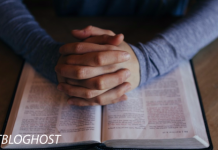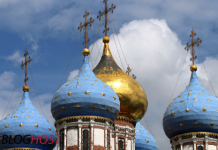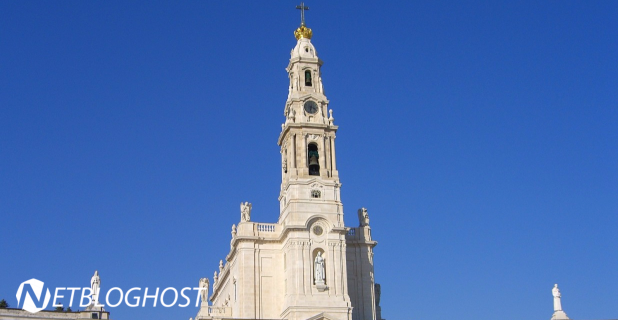The latest issue of the New Oxford Review, which I read to keep up on what is happening on the traditionalist end of the Catholic spectrum, devotes six pages of its letters section to passionate exchanges about Fatima. For those who need a review of the Fatima story: in 1917, three shepherd children, ten-year-old Lucia and her younger cousins, Francisco and Jacinta, claimed to have been visited on several occasions by the Blessed Virgin, in the countryside on the outskirts of the Portuguese town where they lived.
The children reported that Mary gave them three messages: one in which she depicted the horrors of hell; a second in which she promised a world peace to be facilitated by an official church commitment to the conversion of Russia as an expression of devotion to her “Immaculate Heart.” The third message was kept secret by the Vatican for about eight decades, finally being made public in June of 2000. It was interpreted by many to feature a prophecy of the 1981 attempted assassination of Pope John Paul II. However, some Catholics have not been satisfied with the official version of the third message. Indeed, there are dissident groups who insist that Rome is being deceptive on the subject. The fact that Lucia, who died a few years ago after spending her adult life as a cloistered Carmelite, seemed to support the Vatican on the subject, only thickened the plot for the conspiracy theorists.
Mary Jane and I talked quite a bit about Fatima during our eighth grade year together in a town near Albany, New York. I had a mild crush on Mary Jane, a very smart Italian Catholic. Our romance—in so far as it was carried on outside of school activities—consisted of long bike rides interspersed by theological arguments about the role of Mary, the mother of Jesus. Mary Jane was a Fatima enthusiast, and she instructed me in the basic narrative.
I still see those discussions as some of the most interesting theological dialogues I have had on the subject of Marian devotion. For one thing, they focused much on the subject of prophecy. I regularly read the Scofield Bible in those days, which meant that I was schooled in the dispensationalist version of end-times scenarios. I was intrigued with Mary Jane’s very different prophetic checklist. Because of those discussions I know better than to take seriously my Catholic theologian friends when they act puzzled about why so many evangelicals are intensely interested in revealed prophecies about the future.
These days I cannot get my Catholic theologian friends to talk about what Mary Jane and I debated then with so much energy. They seem too embarrassed about the whole thing to want to talk about it. For example, in a casual conversation a few years ago, a priest-theologian friend asked me about my summer plans. When I told him that my wife and I were planning a two-week vacation driving around Portugal, his eyes lit up. “I did a visiting lecture tour there a while back,” he said. “A great country!” After he had proceeded to tell me about some places we should not miss, I mentioned that I was hoping that we could visit Fatima. My friend responded by rolling his eyes. “I avoided that place like the plague,” he said, “and I suggest you do the same.”
My guess is that if I had pushed him to explain his desire to distance himself from the Fatima phenomenon his answer would not be unlike those of my evangelical academic colleagues when asked to comment on the Left Behind novels, or on Benny Hinn’s healing crusades. We are embarrassed by what we see as the excesses of popular movements within our own communities. But in my early adolescence my religious world was permeated with “Bible prophecy” speculations. And what fascinated me was my schoolmate’s focus on similar themes, albeit within a very different context. The Virgin Mother had given the three children secrets about what would soon come to pass in the world, my friend informed me in breathless tones. And if I wanted to be a faithful follower of Jesus today, she warned me, I had better pray that I will be on good terms with the Blessed Virgin. I in turn encouraged her to read the Book of Revelation, especially in the version that had Scofield’s notes about end-time matters. I doubt that she took my advice. I did not follow her counsel as she intended, but I have occasionally dipped into writings about the sort of Marian devotion to which my friend introduced me.
The Fatima phenomenon is not high on my theological agenda these days, although I do take special notice when I happen upon the kind of passionate discussion going on in the New Oxford Review. It is a case in point for me for a larger topic: the interest that I have—and I know I am not alone in this—in the strong religious beliefs of folks who are beyond the borders of my own religious subculture. I had some thoughts about this a while back when I read Susan Sontag’s book Regarding the Pain of Others. It was a follow-up to her much discussed work, On Photography, in which she explored the relationship between photographic images and our understanding of the reality that they depict. In her Pain book, she focuses specifically on photographic documents of extreme violence: Brady’s photos of the dead bodies on Civil War battlefields, Nazi death camp scenes, images of Vietnamese youngsters fleeing a napalm attack and of the execution of a Viet Cong captive. She probes the ways in which we are often fascinated, in spite of ourselves, with such images, likening those experience to the fairly ordinary ways in which “images of the repulsive can also allure.” After all, she observes, we all know “that what slows down highway traffic going past a horrendous car crash is not only curiosity. It is also, for many, the wish to see something gruesome.”
Well, actually visiting Fatima—which we did in spite of my priest friend’s warning—was not exactly a gruesome experience for me. But at times it did come close. I felt like a bit of a voyeur at the shrine, with huge crowds milling around the various booths and worship areas commemorating the appearance of the Virgin. Booth after booth sold life-size wax versions of human body parts, to be thrown into fires as a symbolic request for healing of a specific ailment.
An old woman, all dressed in black, who could hardly walk, got down to crawl on her knees, her eyes closed and hands folded in prayer, for hundreds of yards as she approached one of the many statues of the Virgin. And yet I was fascinated to watch—not unlike the fascination involved in slowing down on the highway to witness the scene of an accident.
In a way, I am sorry to have witnessed all of that. I would rather focus on the memory of two eighth graders—one a Fatima devotee and the other a defender of the Scofield Bible—having energetic discussions together about how to understand God’s workings in our contemporary world.











